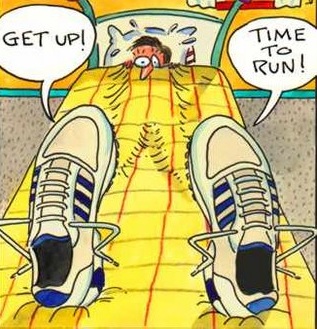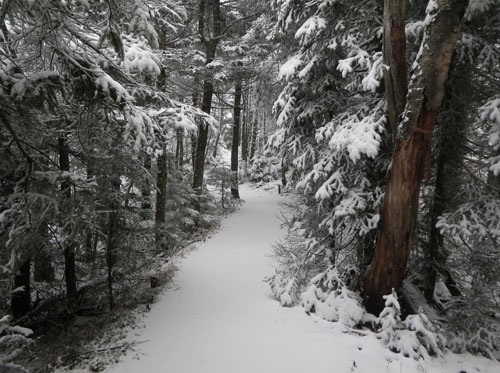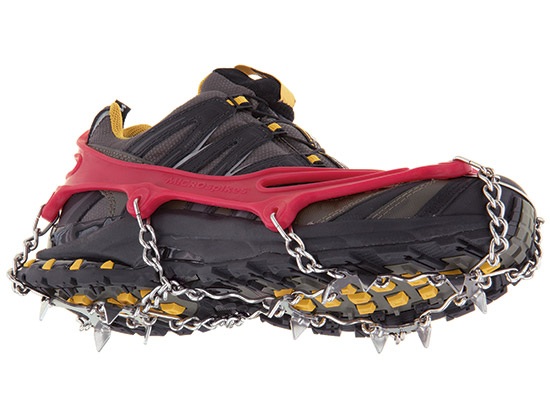The temperature drops, frost falls, leaves cover the ground and the snow begins capping the mountain peaks above. When I started running in 2004, it seemed like all the runners I knew would stop doing serious training for the winter months, taking a break. I had increased my fitness level and feared the impacts of stopping, going back to a sedentary life, so I just kept running and training year-round. But living in the Mountain West required me to change my approach for the winter months.
As the trails filled with snow, and with occasional snow in the valleys, I discovered a wonderful experience running in the valleys. I would seek creative ways to keep my motivation up and explore new areas to run. One of my most favorite times to run during the year is in the early morning as a fresh new snow is falling with an inch or two on the ground. Everything is quiet. The running surface is soft and fast. All is white, with a distinct difference from our colorful, loud attention-grabbing world. Winter running is wonderful with a remarkable cold, but unique experience to discover.
For winters, I shift away from concentrating on getting vertical training and instead concentrate on flatter miles. This shift usually happens for me at the beginning of October and gets me ready for flatter races such as Pony Express Trail 100, Javalina Jundred, Across the Years, and Rocky Raccoon 100. During the winter my mileage actually increases and I have accomplished my highest mileage months in the winter, at times above 400 miles. My average monthly miles for the past eight years for Novembers has been 296 miles and for December, 320 miles.
Clothing
Dressing warmly in the cold weather is critical to stay healthy and avoid injury. Last year some young local runners tried to see how long they could run in the winter months in shorts and summer clothes. I considered that act foolish youthfulness. I believe when those runners become older, they will value more protecting their health and their legs. At my age (56 at the time of this writing), I clearly notice the effects of cold temperatures on my body, shifting blood away from digestion and respiration in attempts to keep the body warmer.
I have a set of dressing strategies depending on the temperature, 30s, 20s, and teens. I rarely go out and run in single digits or less for a couple reason. 1. The danger of getting sickness after being exposed to those frigid temperatures for long periods of time. 2. In Utah such frigid temperatures are usually caused by temperature inversions which brings with it trapped unhealthy air. But I do enjoy winter runs a bit warmer.

If temperatures are above freezing, I may or may not run in shorts. For the past ten years I’ve used a nice cycling jacket that keeps me warm down to about 25 degrees. The extra pockets are nice to carry gloves, hat etc. For the lower 20s, another layer is used, perhaps a fleece vest. For the legs, I’ll just use some cheap tights – anything seems to work fine, even synthetic long john bottoms. For gloves, in the 30s, I use some light running gloves, but if it gets colder I might break out fleece hobo mittens. If even colder, I’ll insert hand warmers. For the head, it will be a light synthetic hat down into the 20s and then a warmer ski hat. A fleece sleeve for the neck and chin works as it gets very cold. As it gets down into the single digits, I might even pull out some ski goggles. With the right running clothes, you can still run for hours out in the cold. Overdressing is a very common problem. You need to find the right balance of clothes to stay warm and minimize the sweating. It is no fun to find yourself far away from home sweaty, tired and cold.
What shoes are used and what about spikes? This is a common question, but the answer is simple. I just use trail shoes with good lugs for traction. Early in my running career, I would try to use Yak-Traks but found that they broke easily, fell off often, and really didn’t help much at all. Later as microspikes became available, I bought a pair of those. But when all is said in done, with the thousands of miles that I have run during the winter, I’ve probably only used the spikes for less than ten miles total. They really are not that helpful unless the surface is icy and slippery. If the surface is packed snow, trail shoes work great, even blasting down steep slopes.
For fluids I usually still use hand-held water bottles. I might start with hot water or warm Ensure, but eventually that might turn into slush or ice. Certain water bottles perform better in the freezing temperatures. I prefer the Ultimate Direction bottles with nipples. The cheap plastic pull-up nipples on other bottle can freeze very quickly. At times I will use bladders, but care must be taken to make sure the hose is tucked in beneath the jacket. Otherwise it will freeze very quickly.
What about snowshoeing or cross-country skiing? It’s not for me. Believe it or not, I am not that adventuresome when it comes to the back country in winter. I choose to stay on packed roads and away from any danger of avalanche or steep trails.
Where to Run
My winter running consists of various types: Dirt roads, Snow packed roads, some pavement, treadmills, frozen lakes and southern warm canyon runs.
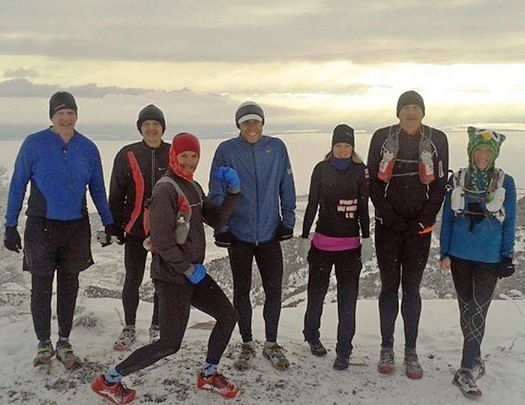
Once the snow flies, all you need to do is find snow-pack routes from ATVs or snow mobiles. Running such surfaces can be great fun. Lake Mountain behind my home is a perfect example. Heading up to the top of the mountain is a dirt road that gets daily 4wd traffic, even in the winter. With several inches of packed snow, the rough rocks are covered and a fast running surface results. Running up to the top may be a bit slower than during the summer, but blasting down the soft snowy surface can be much faster, crazy fun, and easy on the legs. Similar mountain roads exist all over and are just waiting to be run.
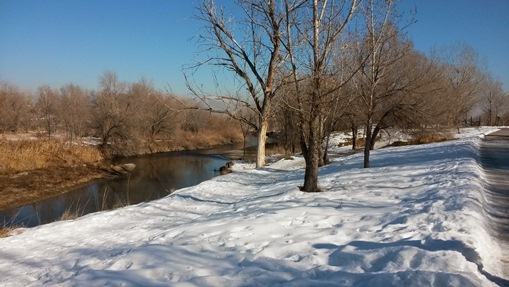
Canal roads are another great winter surface. Near my home are more than a dozen canals that extend from the Jordan Narrows both north and south. Along each canal is a maintenance road. Closer to the cities, these roads can be fenced off but in more rural portions they typically are used without complaint. Because they are very flat, they make great winter runs. The Bonneville Shoreline trail at the foot of the Wasatch Range is another popular choice for winter runs. And for pavement fans, there are miles and miles of running on the Jordan River Parkway (just watch out for ice).
The trails and dirt roads can become muddy at times. I’m not a fan of mud running, so during those times, I’ll find some creative ways to run some big miles on the pavement, using convenient stores along the way as my aid stations. One day I started at Utah Lake and ran the entire stretch of the Provo River Parkway (paved trail) to Vivian Park in Provo Canyon and back. I had never run the entire stretch of the trail and it turned out to be a very fun cold weather run both through the city and up in the canyon.
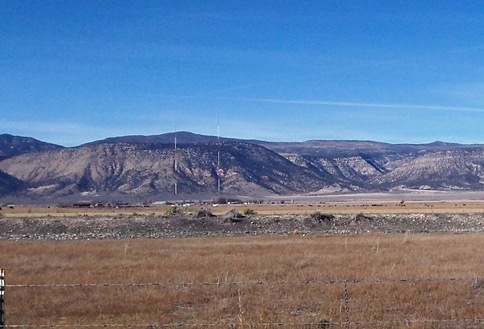
Another day, I attempted to run 97 miles, all the way around the San Pitch Mountains that lie about an hour south of my home. I started at a little town called Levan, about 12 miles south of Nephi, at 1 a.m. Through the night I ran 30 miles straight south on a rural highway. It was terribly cold in patches, well into the teens. I nearly turned back several times, and my water bottles eventually froze, but soon morning came and I ate breakfast at a food mart. My run continued around the mountains but I ultimately stopped short of the finish when my knee became sore from the pavement at about mile 65. But this had been an amazing cold-weather run that keep my enthusiasm up to keep training. Watch my video of this adventure.

For another Loopy cold weather training run, I ran all the way around the southern Oquirrh Mountains in Utah, about 100K, which consisted of about half pavement and the rest dirt road. Watch my video of this adventure.

A great place to run during the winter is the west desert in Utah, close enough to home but lacking deep snow. I discovered the peace and beauty of the Pony Express Trail one winter by just running west out my back door and continuing as far as I could that day.
A favorite event during the winter is the Salt Lake Running Club Winter Series held at historic Saltair on the shore of Great Salt Lake. This series of 5K, 10K, and 15K races are held two weeks apart on the frontage road along the lake shore and for me has been some great winter speed work and competitive running.
As the mornings become frigid and stormy it becomes impractical to go out. The treadmill, while dreaded, becomes a valuable method of training to get through the cold months. In my chapter on Treadmill training I explained how train with treadmills and find some creative ways to motivate me. I had some friends who train year-round at my local housing development community center. I make my appearance in November and depart for good around April. My buddies give me lots of grief in November kidding with me that I’ve been a slacker and haven’t been training since they last saw me in April. I then chew them out for doing indoor training all year. We laugh and then make the room stinky from our sweat.
I suppose the most fame I have about the winter running is because of my runs across the ice on frozen Utah Lake during the winters. The idea came to me in 2007 as I noticed some duck hunters way out on the icy lake surface. In Utah we get some long stretches of high pressure winter inversions that trap the cold air down in the valleys. The temperature can be below freezing for several weeks in a row, causing the lakes to freeze. Overnight the ice fog drops crystals on the ice plate which results in an amazing running surface. See my chapter about running on frozen Utah Lake including many pictures and videos. Typically the lake will freeze solid enough to run by late January. Some years it never freezes safe enough to run.
Eventually the short gloomy winter days start getting to me and I long for spring to arrive. Why wait when just 4-5 hours to the south are amazing warm desert trails to run in the winter? Each winter I’ll make a couple trips to the south to experience the joy of the red deserts running routes that would typically be much too hot to run during the summers.

In another chapter I covered my love of running in Capitol Reef National Park, a great place to run in the winter.I’ve also enjoyed running in Canyonlands and in the lowlands near Zion National Park. Venturing to the canyons near the four-corner region in Southeastern Utah can be an amazing winter running playground. One year I had great fun running a giant loop in Grand Gulch.
Why stop running during the winter months? Don’t. Instead discover new paths and trails to run.


